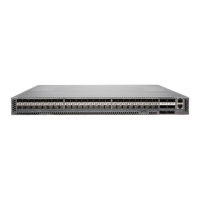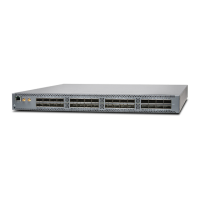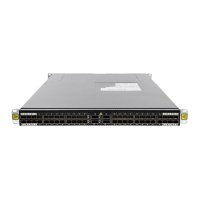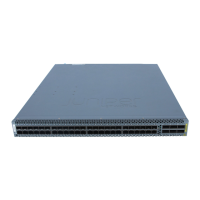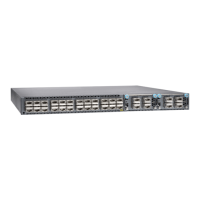Table 3: Supported QFabric System Hardware Configurations
Interconnect DeviceNode DeviceDirector Group
QFabric
System
Configuration
QFX3008-I Interconnect
Device
•
Sixteen to 128 40-Gbps
QSFP+ ports per device
to interconnect the Node
devices to the data plane
network across fiber optic
cables and a high-speed
backplane.
•
Four interfaces (two per
Control Board) provide
Gigabit Ethernet access
to the management
network.
•
There can be a maximum
of 4 Interconnect devices
in the QFabric system.
QFX3500 Node device
•
48 10-Gigabit Ethernet ports connect to
servers, storage, or external networks.
Twelve of these interfaces (0–5, 42–47)
can be configured as 2-Gbps, 4-Gbps, or
8-Gbps FibreChannelover Ethernet ports,
and 36 of these interfaces (6–41) can be
configured as Gigabit Ethernet ports.
•
Four 40-Gbps quad small form-factor
pluggable plus (QSFP+) uplink ports to
connect to the data plane network and
the QFX3008-I Interconnect Devices.
•
Two interfaces provide Gigabit Ethernet
access to the management network.
NOTE:
•
There can be only one network Node
group (containing a maximum of eight
Node devices) to connect the QFabric
system to external networks.
•
A redundant server Node group in the
QFabric system can contain up to 2 Node
devices.
•
There can be a maximum of 128 Node
devices in the QFabric system to connect
to servers and storage devices.
QFX3100 Director group
•
Three interfaces on each
enhanced Director device
provide Gigabit Ethernet
access from the Director
group to the management
network.
•
Requires an out-of-band
Gigabit Ethernet
management network that
connects all QFabric system
devices through a group of
EX4200 Ethernet switches
configured as a Virtual
Chassis. The control plane
network connects the
Director group to the
management ports of the
Node and Interconnect
devices.
QFX3000
QFabricsystem
To complete the system, external Routing Engines running on the Director group
implement QFabric system control plane functions, such as the fabric manager Routing
Engines, network Node group Routing Engines, and fabric control Routing Engines. The
control plane network Virtual Chassis enables the control plane connections between
the Node devices, the Interconnect devices, and the Routing Engines running on the
Director group.
QFabric System Features
A QFabric system provides the following key features:
•
Support for up to 128 Node devices and 4 Interconnect devices, which provides a
maximum of 6144 10-Gigabit Ethernet ports at 3:1 oversubscription (each Node device,
which supports 48 10-Gigabit Ethernet ports, provides up to 160 Gbps of bandwidth
into the QFabric system Interconnect backplane).
•
Low port-to-port latencies that scale as the system size grows from 48 to 6144
10-Gigabit Ethernet ports.
9Copyright © 2012, Juniper Networks, Inc.
Chapter 1: QFX3000 QFabric Switch Overview
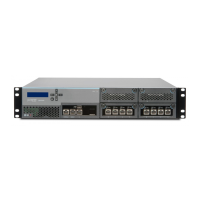
